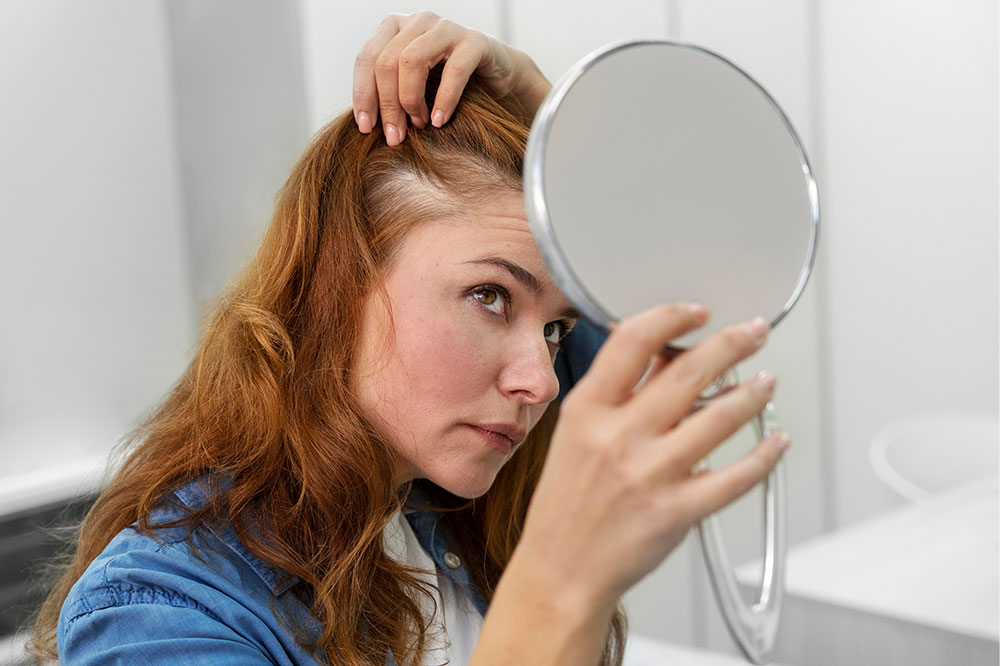
Alopecia areata – Causes, remedies, and management options
Alopecia areata is an autoimmune health condition characterized by hair loss in clumps or patches. Hair loss may occur not only on the scalp but also in other parts, such as the beard, eyebrows, eyelashes, and even inside the nose. The condition is caused when the immune system attacks hair follicles, leading to hair loss. Keep reading to learn more about the causes and treatments for alopecia areata, together with home remedies and management tips.
Causes and risk factors
Genetic predisposition
Recent research points to several gene mutations responsible for the onset of alopecia areata. Individuals with family members who have the condition are likely to inherit it, though a combination of genetic and environmental factors may play a role in its development. 10-20% of individuals with alopecia areata have a family member grappling with the condition.
Asthma and respiratory problems
Alopecia areata and respiratory issues have a Th2-mediated immunological element; consequently, alopecia areata is associated with the onset of respiratory condition.
Down’s syndrome
Some studies have indicated that the gene causing alopecia areata is located in chromosome 21, which is responsible for Down’s syndrome. Hence, Down’s syndrome may be a risk factor for individuals to develop alopecia areata.
Treatment
Amino acids
Amino acids, primarily cysteine, and lysine, are used to treat hair loss in patients. Cysteine is suggested to prevent hair damage and enhance hair texture, while lysine helps with iron absorption; researchers found that supplementation of L-lysine, together with vitamins B and C, iron, selenium, and biotin, resulted in a 39% reduction in hair shedding.
Mind-body intervention
This technique studies the connection between the mind, the body, and human behavior, helping individuals alleviate stress and reduce subsequent mental health consequences. Psychotherapy, aromatherapy, massage, and other such techniques have been studied under this treatment option.
Acupuncture
Studies indicated that acupuncture was associated with hair regrowth within three months of starting the intervention among patients with alopecia areata. Acupuncture is proven to increase blood circulation and hair growth and decrease follicle inflammation.
Home remedies and management tips
Apply fenugreek paste
Dihydrotestosterone (DHT) imbalance can result in hair loss, as this hormone is responsible for steady hair growth. Fenugreek prevents DHT imbalance and hair loss among individuals with alopecia areata. Typically, fenugreek seeds are soaked in water overnight, and a paste prepared from this is applied on the scalp to facilitate hair growth.
Apply crushed garlic with coconut oil
Coconut oil penetrates the hair roots and prevents protein loss, facilitating hair growth. Moreover, garlic has natural antibacterial and antimicrobial properties, helping scalp health. Combining the two ingredients and consistently applying the mixture on the scalp can be highly effective in healing alopecia areata.
Stay hydrated
Dehydration hampers hair growth significantly; contrarily, having plenty of water helps with steady and strong hair growth. It is advised to drink around 3.7 liters of water a day. Other fluids like fresh fruit juices and coconut water can help with hydration.
Apply onion juice
Onion juice is a prevalent option contributing to hair growth among patients with alopecia areata. Besides promoting hair growth, it also improves blood circulation. Patients can apply onion juice on the scalp and hair to prevent hair loss and to facilitate overall hair health.
Foods safe for alopecia areata patients
Beef and pork
Beef and pork contain high cysteine levels, an amino acid essential for good hair growth. They are also excellent sources of folate, B6, and B12, essential for carrying oxygen and nutrients to the scalp.
Egg yolks
A whole cooked egg contains about 10 micrograms of biotin, which is responsible for the production of keratin, a protein essential for hair growth. Thus, regular intake of egg yolks can significantly aid hair growth. Also, foods like meats, legumes, sweet potatoes, seeds, nuts, and bananas are healthy sources of biotin and, therefore, can be included in one’s meal plan.
Bright-colored fruits and vegetables
Orange or yellow fruits and vegetables contain high levels of beta-carotene, which facilitates the production of vitamin A. Vitamin A is a fat-soluble micronutrient necessary for healthy hair and skin. Thus, including these fruits and vegetables can help reduce hair loss and promote healthy hair.
Greek yogurt
Probiotics help restore good bacteria in the body and reduce scalp inflammation. Greek yogurt is a rich source of probiotics, besides containing high levels of protein, and is an excellent inclusion to the meal plan for alopecia areata patients.
Foods alopecia areata patients should avoid
Sometimes, food intolerances can trigger alopecia areata. A way to identify if food tolerances are triggering the condition is to eliminate grains, legumes, nightshades, sugar, coffee, eggs, etc., one by one and add them back after a few days. If the condition improves upon eliminating a certain food item, there are chances that a patient is intolerant to it. In addition, processed meats and trans fats contain empty calories and can increase inflammation in the body. Therefore, limiting or avoiding processed meats, foods high in saturated fats, fried foods, and sugary items is advised.




